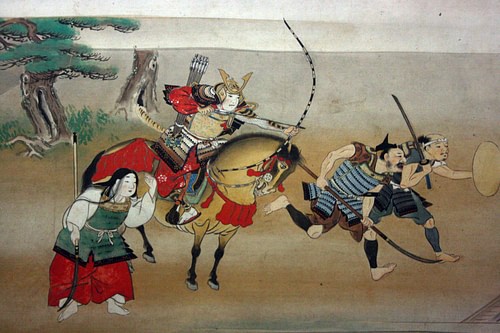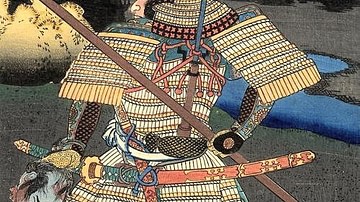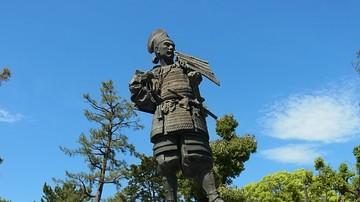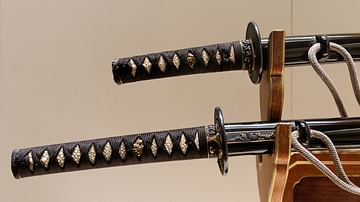
The Sengoku Period (Sengoku Jidai, 1467-1568 CE), also known as the Warring States Period, was a turbulent and violent period of Japanese history when rival warlords or daimyo fought bitterly for control of Japan. The period falls within the Muromachi period (Muromachi Jidai, 1333-1573 CE) of Japanese medieval history when the Ashikaga shogun capital was located in the Muromachi area of Heiankyo (Kyoto). The beginning of the Sengoku period witnessed the Onin War (1467-1477 CE) which destroyed Heiankyo. The fighting that followed over the next century would eventually reduce the warlords to only a few hundred in number as the country was effectively carved up into princedoms. Eventually, one warlord rose above all his rivals: Oda Nobunaga, who set Japan on the road to unification from 1568 CE.
The Daimyo & Ashikaga Shogunate
The Ashikaga Shogunate (1338-1573 CE) held control of the central part of Japan, and the bureaucracy at the capital was relatively efficient, but the outer provinces were left semi-independent as local warlords or daimyo ruled their own lands how they saw fit. Local officials and estate managers such as the jito found it much more difficult to secure the taxes the state was due from landlords who now had no fear of any government reprisals. The daimyo (literally 'Great Names') were feudal lords who commanded personal armies of samurai or anyone else willing to take up arms and defend their lord's estates and help expand it.
Some daimyo were aristocrats with a long heritage of land ownership, others were military governors (shugo) who went independent from the weakened shogunate, and there were also new lords who were the sons of tradesmen who had gathered together a small army to simply take by force the land of others. The phenomenon of new rulers overthrowing the established order and of branch families taking the estates of the traditional major clans became known as gekokujo or 'those below overthrowing those above.' The consequence of all the upheaval was that Japan became a patchwork of feudal estates centred around their individual castles and fortified mansions.
In the absence of a strong central government - a situation only worsened by the shogun Yoshimasa's (r. 1449-1473 CE) decision to retreat to his Ginkakuji palace to contemplate the arts; the rule of law was very often replaced by the rule of force. The more powerful lords absorbed the lands of their weaker rivals and became known as sengoku daimyo. The warlords then passed on their position of strength to their male heir and so the position of daimyo became hereditary unless challenged by ambitious subordinate commanders. The wealth of the daimyo came from commerce, trade, and taxes imposed on those peasants who farmed on their estates. Daimyo may have been a law unto themselves but many of them did formulate law codes to better regulate the sometimes thousands of people under their command. These laws could cover anything from the prohibition of building castles and fortifications in their territory to measures that avoided wasting money on expensive theatre actors brought in from outside the daimyo's domain.
The Onin War
The Warring States period kicked off with the Onin War (Onin No Ran, 1467-1477 CE). This civil war - its name derives from the year period - broke out because of the bitter rivalry between the Hosokawa and Yamana family groups. By the end of the decade, though, the fighting had sucked in most of the influential clans of Japan. The conflict revolved around each side backing a different candidate for the position of shogun - a particularly pointless debate since shoguns, like the emperors, no longer had any real power. Rather, the war is seen by historians as merely a result of the overly aggressive warlords of Japan being rather too keen to put their samurai to some use - good or bad. Even when the war ended in 1477 CE there was no victor and no resolution to the inherent militarism that fractured Japan for the next century as warlords fought each other with no one in particular ever achieving any dominance. In addition, the fighting destroyed most of Heiankyo and was brutal in the extreme, as here summarised by the historian J. L. Huffman:
Most of the leading samurai families took part in what can only be described as an orgy of violence, burning of temples, ransacking shops, massacring hostages, and defiling the dead. By the war's end in 1477 CE, the fighting had moved to the countryside because all vestiges of central control had been destroyed and Kyoto had been wiped out. “For blocks on end,” said the conflict's leading chronicler, “birds are the sole sign of life.” (44-45)
One anonymous poem, composed c. 1500 CE, captures the general mood of the times - that Japan was hurtling down a road that led only to destruction:
A bird with
One body but
Two beaks,
Pecking itself
To death.
(Henshall, 243)
The Onin War had sorted out who were the weak and the strong daimyo, who thus became much fewer in number (by 1600 CE there would be only about 250 of them in all of Japan). A consequence of this consolidation of resources was that field armies now numbered not hundreds but tens of thousands of warriors. The composition of such armies became more complex with specialised roles created such as the lightly armoured infantry, the ashigaru. There were cavalry units and men dedicated to procuring and transporting supplies and equipment. Battles had to be fought at greater distances from the daimyo's castle and so lighter weapons became popular to facilitate troop movement. Halberds, pikes and, in the second half of the period, matchlock guns were adopted by some daimyo.
Treachery and ignoble acts were as common as in any other war, but there did develop a lot of mythmaking, especially involving the samurai warriors and the daimyo, eager to project a public image that glorified themselves and intimidated their enemies. The heavily armoured samurai, armed with sword and bow, were often presented in later literature set back in this period as disciplined, skilful, loyal, and honourable fighters, just as the medieval knight of Europe was presented in chivalric literature.
Castles
As a result of the constant threat of war and pillage in this period, castles were built with much greater frequency than previously in towns, at mountain passes, along vital roads, and on larger estates. The latter type, which could take the form of fortified mansions, was known as yashiki; Ichijodani (base of the Asakura family) and the moated Tsutsujigasaki (of the Takeda family) were excellent examples of this building trend. Some castles, such as Omi-Hachiman near Lake Biwa, caused an entire town to later spring up around them, the jokomachi. Not as yet the grand multi-storied stone structures of the 17th century CE, the castles of the period were, nevertheless, often sophisticated defensive structures despite the predominant use of wood. Constructed on large stone bases, the wooden superstructures included walls, towers, and gates, which had narrow windows for archers and from which hung boulders on ropes, ready to be dropped on any attackers.
Local Government
Villages grew in number and size as farmers sought security in numbers and worked together to produce more and benefit from communal projects such as digging irrigation channels and building waterwheels. In the absence of any authority from the central government, many villages governed themselves. Small councils or so were formed, which made decisions regarding laws and punishments, organised community festivals, and decided on regulations within the community. Some villages got together to form leagues or ikki for their mutual benefit, with some even challenging and winning battles against local daimyo, while others at least took advantage of their lord's absence on campaign to better the lot of the peasantry. There were several major peasant revolts, too, notably in Yamashiro province between 1485 and 1493 CE.

Towns and cities became larger, with many having a population of over 30,000, thanks to a boom in international trade (daimyo wanted foreign luxury goods like Ming porcelain to demonstrate their status), weekly markets, and the development of trade guilds. Measures, weights, and currencies were standardised in many domains to facilitate trade. Meanwhile, the fortunes of the many Buddhist temples scattered across Japan plummeted as no longer backed by the state they could not so easily extract contributions from local communities. Worse was to come when the temples were directly attacked during the reign of the one warlord to establish dominance: Oda Nobunaga.
Oda Nobunaga
The Ashikaga Shogunate would be terminated by the warlord Oda Nobunaga (l. 1534-1582 CE) who finally brought some stability to central Japan. Oda Nobunaga had expanded his territory gradually through the 1550/60s CE from his base at Nagoya Castle as he defeated all comers thanks to his martial skills and innovative use of firearms. The Warring States period comes to an end with the seizure of Heiankyo by Nobunaga in 1568 CE. The warlord then exiled the last Ashikaga shogun, Ashikaga Yoshiaki, in 1573 CE. The unification of the country would continue under Nobunaga's immediate successors, Toyotomi Hideyoshi (1537-1598 CE) and Tokugawa Ieyasu (1543-1616 CE). This next period of Japan's history would be known as the Azuchi-Momoyama period (1568/73-1600 CE).
This content was made possible with generous support from the Great Britain Sasakawa Foundation.







